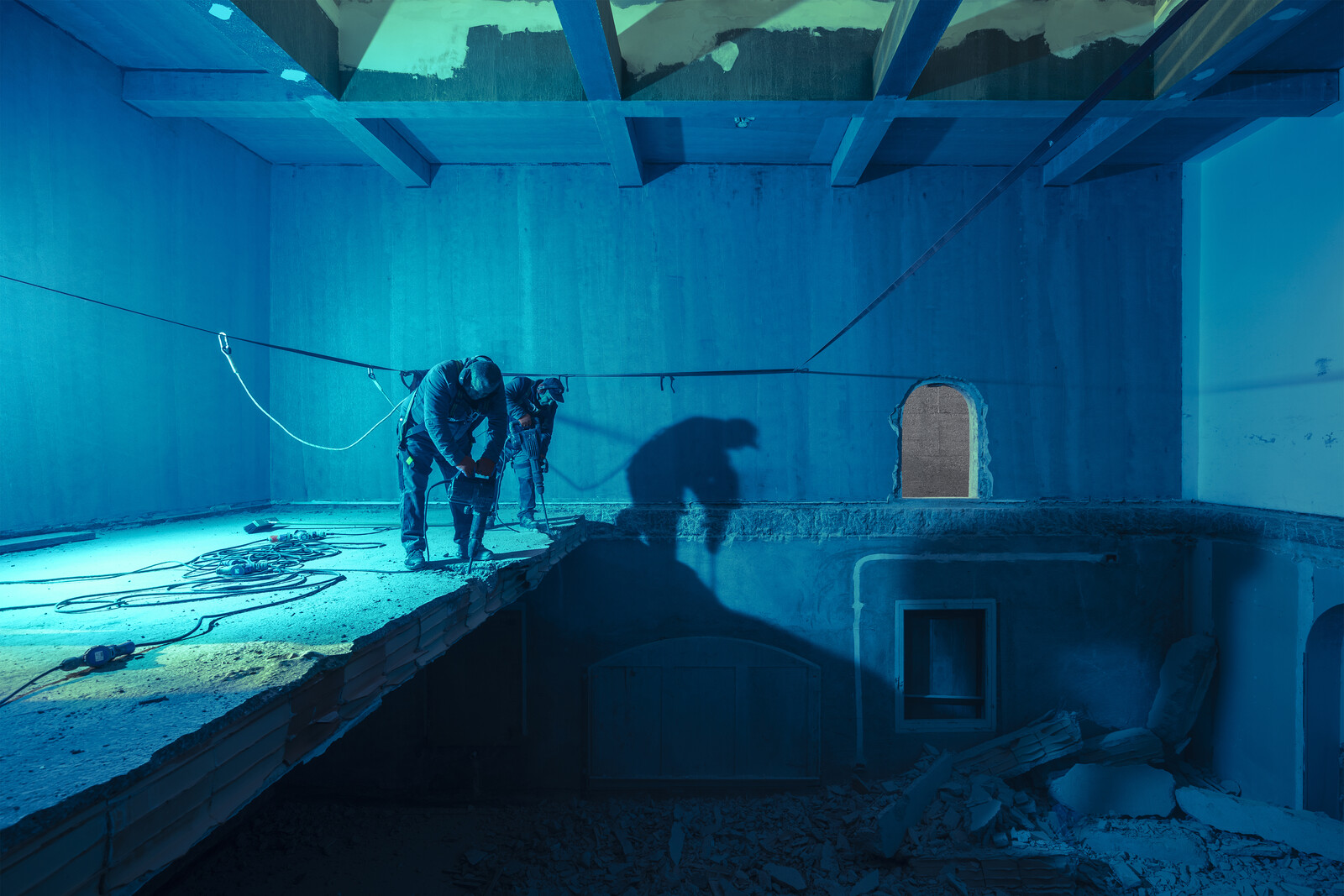Open
May 22–November 21, 2021
For the past two years, the Russian Federation Pavilion has explored the public role and social relevance of cultural institutions in times of global crisis, with the intent to rebuild itself on more solid and inclusive grounds.
Initiating the reconstruction of both its architectural and institutional structures, the Russian Pavilion has located an ideal testing ground to experiment with more empathetic and meaningful forms of alliances and kinships in the amorphous, nebulous space suspended across different dimensions—the physical, the digital and everything in between. In the tension between these three, Open has found a tentative answer to the question posed by the curator of the 17th Venice Architecture Biennale, Hashim Sarkis: How Will We Live Together?
The Russian Pavilion considers how we can rethink cultural institutions through overlapping perspectives: the transformation of its own physical architecture, the digital environments that we access daily, and the network of relationships and individuals that populate them.
The three dimensions first converged in Open?, the online platform that was conceived in response to the postponement of the 17th Venice Architecture Biennale. In early 2020, in the face of harsh lockdowns that put a break on our social and cultural exchange, the Russian Pavilion migrated online and continued to serve as a journal for new contents and collaborations, while connecting to audiences beyond the perimeter of Giardini and building up an archive for biennials to come. What was meant to be a physical space for encounters transformed into a virtual gathering venue for a vast ecosystem of artists, architects, and thinkers.
Today the Pavilion’s exploratory journey has crystallized through three interconnected components:
–The showcase of an almost empty architecture, giving space to the project of transformation of the pavilion developed by the young Russian-Japanese office, KASA / Kovaleva and Sato Architects. Selected through an open call and reflecting on the legacy of the pavilion’s architect Alexey Schusev, KASA’s proposal engages with different modes of care towards architecture, people and ecosystems, by opening up the building towards the gardens and the lagoon.
–A gamer room that explores the potential of digital environments as a testing ground for world-building practices and institution-making through a curated selection of three Russian indie video games, including a special commissioned work by Mikhail Maximov, accompanied by a series of theoretical contributions by philosophers, technologists, architects and sociologists, and a film program that further investigate gaming and digital culture through the lens of Russia and beyond.
–A book entitled Voices (Towards Other Institutions),* featuring a collection of 28 commissioned texts that put forward an array of interdisciplinary perspectives into alternative ways of thinking about and acting within cultural institutions. Voices was originally published between May 2020 and May 2021 on the online platform Open?.
With Open, the Russian Pavilion aims to effectively function as a more porous, inclusive, critical and self-critical cultural institution—taking shape gradually over time. Throughout the past, difficult months, it has continued to systematically interrogate itself, eventually evolving into a collective effort to curate and care for an institution as a “living object.”
Open, the Russian Federation Pavilion as part of the 17th Venice Architecture Biennale titled How Will We Live Together?, is commissioned by Teresa Iarocci Mavica, director of the V-A-C Foundation, curated by Ippolito Pestellini Laparelli in collaboration with the curator’s team: Erica Petrillo, Giacomo Ardesio, Vladimir Nadein, Liza Dorrer and Dasha Nasonova, and managed by Anastasia Karneeva of Smart Art.
With projects by: KASA / Kovaleva and Sato Architects, Mikhail Maximov, with music by Vladmir Rannev, Lion & Unicorn, Yuliya Kozhemyako, Ilia Mazo, Electric Red, Volchok, Pavel Milyakov aka Buttechno
With contributions by: Alice Bucknell, Federico Campagna, Emanuele Coccia, Cat Goodfellow, Daria Kalugina, Alina Nazmeeva, Alexander Vetushinsky
With movies by: Alice Bucknell, Ismaël Joffroy Chandoutis, Antoine Chapon, Dina Karaman, Lawrence Lek, Benjamin Nuel, Total Refusal, Keiken & George Jasper Stone
Exhibition design: 2050.plus (Kamil Hilmi Dalkir, Camilla Morandi, Guglielmo Campeggi, Mattia Inselvini) with KASA / Kovaleva and Sato Architects
Visual identity: Lorenzo Mason Studio (Lorenzo Mason, Dafne Pagura, Simone Spinazzè)
With texts by: Ramon Amaro, Sepake Angiama, Paola Antonelli, Alessandro Bava, Daniel Blanga-Gubbay, Giovanna Borasi, Francesca Bria, Alice Bucknell, Konstantin Budarin, Ilya Budraitskis, Anna Kamyshan, Adrian Lahoud, Beatrice Leanza, Chus Martínes & Markus Reymann, Timothy Morton, Gabriella Gómez-Mont, Ivan L. Munuera, Alina Nazmeeva, Elise By Olsen, Marina Otero Verzier, Kiril Serebrennikov, Sergei Sitar, Jonas Staal, Léa-Catherine Szacka, Jenna Sutela, Pelin Tan, James Taylor-Foster, Oxana Timofeeva
For press inquiries please contact Sander Manse, Send/Receive.
*Voices (Towards Other Institutions) is designed by Lorenzo Mason Studio and published by Lenz Press.



